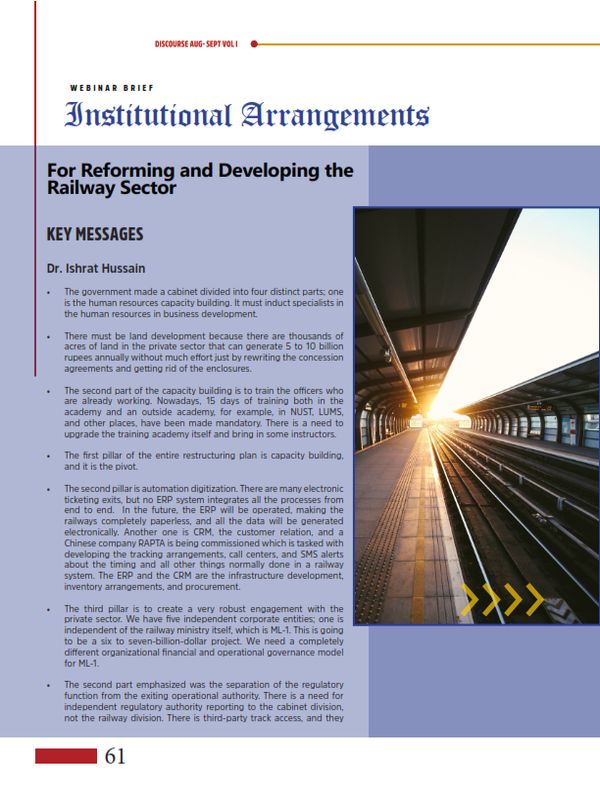
Pakistan Institute of Development Economics
- Home
Our Portals
MenuMenuMenuMenuMenuMenuMenu - ResearchMenuMenuMenuMenuMenuMenuMenu
- Discourse
- The PDR
- Our Researchers
- Academics
- Degree Verification
- Thesis Portal
- Our Portals
Institutional Arrangements For Reforming And Developing The Railway Sector (Webinar Brief)
Publication Year : 2022
Author: PIDE
KEY MESSAGES
Dr. Ishrat Hussain
- The government made a cabinet divided into four distinct parts; one is the human resources capacity building. It must induct specialists in the human resources in business development.
- There must be land development because there are thousands of acres of land in the private sector that can generate 5 to 10 billion rupees annually without much effort just by rewriting the concession agreements and getting rid of the enclosures.
- The second part of the capacity building is to train the officers who are already working. Nowadays, 15 days of training both in the academy and an outside academy, for example, in NUST, LUMS, and other places, have been made mandatory. There is a need to upgrade the training academy itself and bring in some instructors.
- The first pillar of the entire restructuring plan is capacity building, and it is the pivot.
- The second pillar is automation digitization. There are many electronic ticketing exits, but no ERP system integrates all the processes from end to end. In the future, the ERP will be operated, making the railways completely paperless, and all the data will be generated electronically. Another one is CRM, the customer relation, and a Chinese company RAPTA is being commissioned which is tasked with developing the tracking arrangements, call centers, and SMS alerts about the timing and all other things normally done in a railway system. The ERP and the CRM are the infrastructure development, inventory arrangements, and procurement.
- The third pillar is to create a very robust engagement with the private sector. We have five independent corporate entities; one is independent of the railway ministry itself, which is ML-1. This is going to be a six to seven-billion-dollar project. We need a completely different organizational financial and operational governance model for ML-1.
- he second part emphasized was the separation of the regulatory function from the exiting operational authority. There is a need for independent regulatory authority reporting to the cabinet division, not the railway division. There is third-party track access, and they will negotiate the charges, which the government of Pakistan will own. The fourth company will for the freight operations that will be independent, and FTC has been hired an individual from the private sector on an open comparative basis. It will give complete freedom to operate. The fifth will be the rail passenger outsourcing the passenger train to the private sector.
- Pakistan faces the main hurdle regarding coordination failures in the government, and all the ministries want to work independently. The committee’s progress has been quite satisfactory, e.g., financial earnings this year is about two to three billion.
- Another main hurdle regarding retirees’ operation of the railways. There are 115000 retirees of the railways, and they get 35 billion rupees annually. There is no way of verification of these individuals. So we should need to introduce a biometric verification system for the pensioners because it creates a deficit.
- o make the railway sector competitive outside the federal railway sector, the provinces could take it over by their own companies rather than Pakistan railways. Lahore metropolitan metro with Multan Peshawar has already taken them out of the central railways. Once it gets going, the Karachi circular railway would also be having its own company rather than Pakistan railways.
- here is a need for an HR advisor who would design the incentive structures so that the performance management system is not based on seniority but on achieving the targets, which is a long-term phenomenon. Our assets both on the land side and the track to giving out to the private sector after making sure about their capability are beneficial to impalement to these changes.
- We need to transform Lahore, Karachi, Rawalpindi, and Peshawar railway stations to make them like airports with decent shopping plazas, cafes, and restaurants, i.e., to make money from commercial enterprises apart from the train fares like the model of Delhi metro railway.
Mr. Asim Siddiqui
- With private sector engagement, Pakistan freight trains speed increased and time reduced from 80 hours to 60 hours, so there is improved due to restructuring.
- Sixty percent of the freight revenue comes from three and a half million tons of cargo for the Sahiwal is 44 billion.
- We have the Pakistan railway strategic plan multilateral institutions which worked on railway strategic plan for Private sector engagement.
- There is a need to change policy and agents, and it comes through training or a project directorate. There is a need for a road map with timelines and milestones thought out plan, not just a policy. Long-term sustainability also needs to be ensured.
- Government should also focus on asset management. Terminals investment, infrastructure management, and track access projects should also be given to the private Mr. Asim Siddiqui sector for efficiency.
- The private sector is basically on the top line for raising passenger and freight revenue. Ministries need to focus on staffing competent people with subject specialists and with assigning clear roles and responsibilities.
- There is a need for the branding of the train, the railway stations, and the track. It all depends on the visibility of the private sector. There are private-sector people now in Pakistan railways work as marketing head and head of HR as well.
- Just as IPP policy, there was a total ban on public sector investment in power generation. Government should consider not expanding or investing public money in rolling stock only invest in infrastructure.
© 2024 Pakistan Institute of Development Economics



